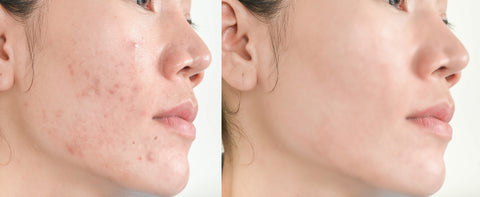Salicylic Acid Review
Salycilic Acid - BHA
Beta Hydroxy Acids (BHAs) are a group of acids often found in flowering plants and herbs. The most common one is Salicylic Acid, believed to dissolve dead skin cells and, this way, to contribute to the evening and smoothening of the skin surface. They present some similarities to Alpha Hydroxy Acids (AHAs).
Various studies have shown that Salicylic Acid contains anti-inflammatory and antibacterial properties [1]. As a member of the aspirin family, Salicylic Acid achieves analgesic and anti-inflammatory properties by truncating AA Cascade. Salicylates are active components in terms of inflammation control, by altering gene expressions. They suppress the expression of inflammatory genes by inhibiting DNA-binding actives.
Salicylic Acid is known to decrease both the frequency and severity of acne eruptions, by reducing acne-related inflammation. Its exfoliating features help to reduce blackheads and whiteheads (also known as comedones).
Salicylic Acid is also used to treat other inflammatory skin conditions such as rosacea and photoaged skin. The topical application of Salicylic Acid (30%) has proven to be effective in terms of the minimisation of aged-related pigmentation spots and in the reduction of fine lines and wrinkles.
However, it is equally important to mention that, if used in too high concentrations and/or too frequently, Salicylic Acid can cause redness, epidermolysis and skin sensitivity [2].
What Strength of Salicylic Acid is Recommended by Dermatologists for Acne Breakouts?
| Form | Percentage of salicylic acid | Application frequency |
| gel | 0.5–5% | once per day |
| lotion | 1–2% | 1 to 3 times per day |
| ointment | 3–6% | as needed |
| pads | 0.5–5% | 1 to 3 times per day |
| soap | 0.5–5% | as needed |
| solution | 0.5–2% | 1 to 3 times per day |
BHA vs AHAs
Salicylic Acid (BHA) and Alpha Hydroxy Acids (AHAs) can be distinguished through their chemical features. Salicylic acid is lipid soluble, whilst the AHAs are water soluble. Due to that, the way these two groups of acids function and the effect they have on the skin vary. Salicylic acid usually impacts mostly the upper epidermis. On the other hand, AHAs are able to penetrate de dermis. This might explain why the prolonged stinging sensation reported by patients who have used AHAs differs from that of the ones using BHA (who normally experience stinging for shorter periods of time) [2].

BHA is lipophilic (i.e., lipid soluble) which, contrarily to AHAs (water soluble) makes it likely to penetrate the sebaceous matter in the follicles. BHA is, thus, a particularly effective exfoliator. A study in which specialists established a comparison between the number of microcomedones registered in biopsies of women using 2% salicylic acid and women using 8% glycolic acid. This was done so as to test BHA’S comedolytic properties (i.e., their capacity to inhibit the formation of comedones). This piece of research allowed the researchers to conclude that the 8% glycolic acid formulation did not contribute to reduce the density / quantity of microcomedones. On the other hand, BHA application resulted in a substantial decrease [2].

Due to its anti-inflammatory action, salicylic acid is also used in acne peels. A clinical trial which took place in 1995 tested a product combining glycolic and salicylic acids. When compared to benzoyl peroxide, it became evident that it statistically reduced more inflammatory acne lesions. It is important to note that one of this study’s key finding was that using a combination of AHAs and BHAs was more effective when tackling acne symptoms than using salicylic acid alone [2].
BHA (Salicylic Acid) as an exfoliator
Daily exfoliation is a crucial step within one’s skincare, as it actively contributes to smoothen and hydrate the skin. Leave-on BHA exfoliants allow a fast removal of dead skin cells while they are gentle to skin. They are also known for helping tackle acne-related symptoms, decrease the incidence of blackheads and reduce enlarged pores. Through BHA exfoliators, skin will gain a softer, brighter and younger appearance, as they optimise hydration and prevent skin ageing.
BHA exfoliators concentrate their action on the upper layer of the skin, where dead skin cells tend to be agglomerated. Their ability to penetrate the skin’s natural oil to exfoliate the pore lining is what makes it particularly effective in terms of pore size reduction [3].
BHA exfoliation products differ from most scrubs. Scrubs usually contain a high percentage coarse ingredientes that may be harsh to skin – they may tear the surfasse of the skin and cause severe long-term damage. This does not happen with BHA exfoliants – they are not scrubs. BHA is neither abrasive nor corrosive. On the contrary, it has soothing features and it is highly anti-inflammatory, which makes it gentler on skin than most scrubs available in the market.
References
[1] Wu, K.K. (2007) 'Salicylates and their Spectrum of Activity', Anti-Inflammatory & Anti-Allergy Agents in Medicinal Chemistry, 6(4). https://doi.org/10.2174/187152307783220031.
[2] Baumann, L & Keri, J. (2009) 'Acne (Type 1 Sensitive Skin)' In L. Baumann, S. Saghari & E. Weisberg (Eds.) Cosmetic Dermatology: Principles and Practice (pp. 121-127). US: McGraw-Hill Companies.
[3] Saxena, V. & Yadav, K. (2020) 'Glycolic Acid, Lactic Acid, Mandelic Acid, Salicylic Acid, Citric Acid, Gluconolactone: Skin Exfoliators in Combination Therapy of Acne Vulgaris' International Journal of Research in Engineering, Science and Management, 3(10), pp. 54-55.
[4] Salvona Technologies (2018)
[5] https://www.healthline.com/health/skin/salicylic-acid-for-acne#how-to-use


